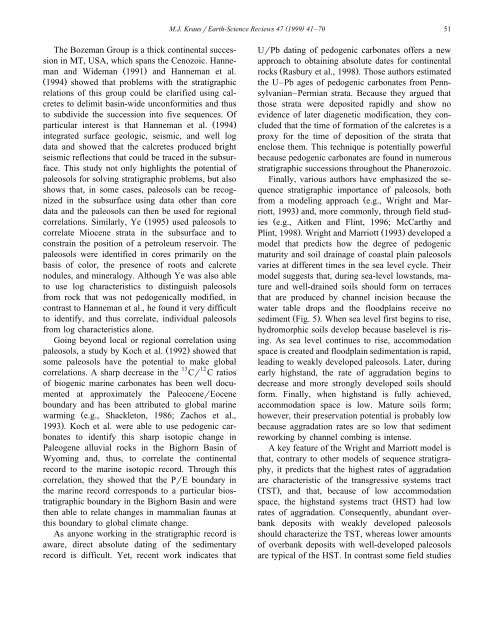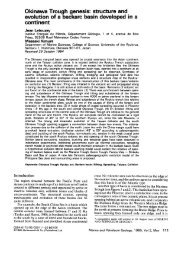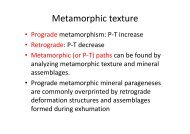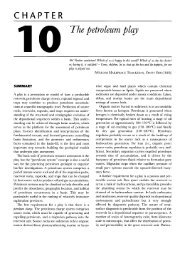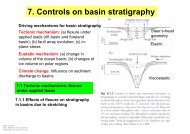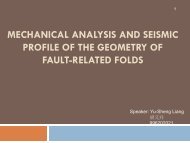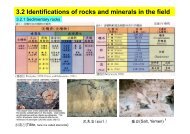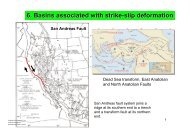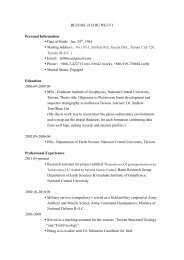Paleosols in clastic sedimentary rocks: their geologic applications
Paleosols in clastic sedimentary rocks: their geologic applications
Paleosols in clastic sedimentary rocks: their geologic applications
- No tags were found...
Create successful ePaper yourself
Turn your PDF publications into a flip-book with our unique Google optimized e-Paper software.
( )M.J. KrausrEarth-Science ReÕiews 47 1999 41–70 51The Bozeman Group is a thick cont<strong>in</strong>ental succession<strong>in</strong> MT, USA, which spans the Cenozoic. Hannemanand Wideman Ž 1991.and Hanneman et al.Ž 1994.showed that problems with the stratigraphicrelations of this group could be clarified us<strong>in</strong>g calcretesto delimit bas<strong>in</strong>-wide unconformities and thusto subdivide the succession <strong>in</strong>to five sequences. Ofparticular <strong>in</strong>terest is that Hanneman et al. Ž 1994.<strong>in</strong>tegrated surface <strong>geologic</strong>, seismic, and well logdata and showed that the calcretes produced brightseismic reflections that could be traced <strong>in</strong> the subsurface.This study not only highlights the potential ofpaleosols for solv<strong>in</strong>g stratigraphic problems, but alsoshows that, <strong>in</strong> some cases, paleosols can be recognized<strong>in</strong> the subsurface us<strong>in</strong>g data other than coredata and the paleosols can then be used for regionalcorrelations. Similarly, Ye Ž 1995.used paleosols tocorrelate Miocene strata <strong>in</strong> the subsurface and toconstra<strong>in</strong> the position of a petroleum reservoir. Thepaleosols were identified <strong>in</strong> cores primarily on thebasis of color, the presence of roots and calcretenodules, and m<strong>in</strong>eralogy. Although Ye was also ableto use log characteristics to dist<strong>in</strong>guish paleosolsfrom rock that was not pedogenically modified, <strong>in</strong>contrast to Hanneman et al., he found it very difficultto identify, and thus correlate, <strong>in</strong>dividual paleosolsfrom log characteristics alone.Go<strong>in</strong>g beyond local or regional correlation us<strong>in</strong>gpaleosols, a study by Koch et al. Ž 1992.showed thatsome paleosols have the potential to make globalcorrelations. A sharp decrease <strong>in</strong> the 13 Cr 12 C ratiosof biogenic mar<strong>in</strong>e carbonates has been well documentedat approximately the PaleocenerEoceneboundary and has been attributed to global mar<strong>in</strong>ewarm<strong>in</strong>g Že.g., Shackleton, 1986; Zachos et al.,1993 .. Koch et al. were able to use pedogenic carbonatesto identify this sharp isotopic change <strong>in</strong>Paleogene alluvial <strong>rocks</strong> <strong>in</strong> the Bighorn Bas<strong>in</strong> ofWyom<strong>in</strong>g and, thus, to correlate the cont<strong>in</strong>entalrecord to the mar<strong>in</strong>e isotopic record. Through thiscorrelation, they showed that the PrE boundary <strong>in</strong>the mar<strong>in</strong>e record corresponds to a particular biostratigraphicboundary <strong>in</strong> the Bighorn Bas<strong>in</strong> and werethen able to relate changes <strong>in</strong> mammalian faunas atthis boundary to global climate change.As anyone work<strong>in</strong>g <strong>in</strong> the stratigraphic record isaware, direct absolute dat<strong>in</strong>g of the <strong>sedimentary</strong>record is difficult. Yet, recent work <strong>in</strong>dicates thatUrPb dat<strong>in</strong>g of pedogenic carbonates offers a newapproach to obta<strong>in</strong><strong>in</strong>g absolute dates for cont<strong>in</strong>ental<strong>rocks</strong> Ž Rasbury et al., 1998 .. Those authors estimatedthe U–Pb ages of pedogenic carbonates from Pennsylvanian–Permianstrata. Because they argued thatthose strata were deposited rapidly and show noevidence of later diagenetic modification, they concludedthat the time of formation of the calcretes is aproxy for the time of deposition of the strata thatenclose them. This technique is potentially powerfulbecause pedogenic carbonates are found <strong>in</strong> numerousstratigraphic successions throughout the Phanerozoic.F<strong>in</strong>ally, various authors have emphasized the sequencestratigraphic importance of paleosols, bothfrom a model<strong>in</strong>g approach Že.g., Wright and Marriott,1993.and, more commonly, through field studiesŽe.g., Aitken and Fl<strong>in</strong>t, 1996; McCarthy andPl<strong>in</strong>t, 1998 .. Wright and Marriott Ž 1993.developed amodel that predicts how the degree of pedogenicmaturity and soil dra<strong>in</strong>age of coastal pla<strong>in</strong> paleosolsvaries at different times <strong>in</strong> the sea level cycle. Theirmodel suggests that, dur<strong>in</strong>g sea-level lowstands, matureand well-dra<strong>in</strong>ed soils should form on terracesthat are produced by channel <strong>in</strong>cision because thewater table drops and the floodpla<strong>in</strong>s receive nosediment Ž Fig. 5 .. When sea level first beg<strong>in</strong>s to rise,hydromorphic soils develop because baselevel is ris<strong>in</strong>g.As sea level cont<strong>in</strong>ues to rise, accommodationspace is created and floodpla<strong>in</strong> sedimentation is rapid,lead<strong>in</strong>g to weakly developed paleosols. Later, dur<strong>in</strong>gearly highstand, the rate of aggradation beg<strong>in</strong>s todecrease and more strongly developed soils shouldform. F<strong>in</strong>ally, when highstand is fully achieved,accommodation space is low. Mature soils form;however, <strong>their</strong> preservation potential is probably lowbecause aggradation rates are so low that sedimentrework<strong>in</strong>g by channel comb<strong>in</strong>g is <strong>in</strong>tense.A key feature of the Wright and Marriott model isthat, contrary to other models of sequence stratigraphy,it predicts that the highest rates of aggradationare characteristic of the transgressive systems tractŽ TST ., and that, because of low accommodationspace, the highstand systems tract Ž HST.had lowrates of aggradation. Consequently, abundant overbankdeposits with weakly developed paleosolsshould characterize the TST, whereas lower amountsof overbank deposits with well-developed paleosolsare typical of the HST. In contrast some field studies


